A day in the life
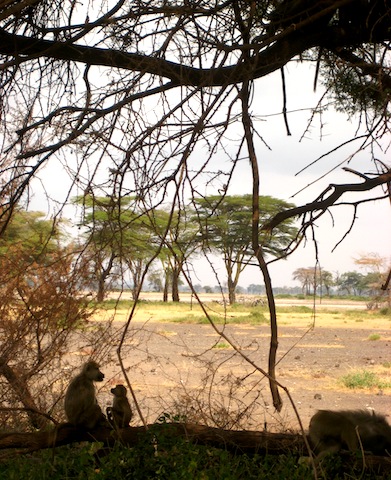
In order to provide an overview of the Amboseli baboons' daily activities and to convey some impression of the individuality of these primates, we here present--with some "poetic license"--a fictitious but typical day in the life of Alice at the time that she was a yearling baboon. For a thorough technical treatment of foraging in yearling baboons see Stuart Altmann's book, "Foraging for Survival", published in 2000 by University of Chicago Press.
Sunrise. The early morning light, the chilly air, and a coucal's call awakened Alice. She and the other members of her group had spent the night high up in one of their favorite groves of fever trees [4]. She snuggled more closely into the warm lap of her elderly mother, Alto, took a nipple into her mouth and suckled [28, 38, 51]. Her mother half awoke and gently embraced her. As Alice suckled, she looked out over her mother's arms. Several feet away, her three-year-old sister, Dotty, was still asleep, sitting hunched over. Higher up was Alice's oldest sister, Spot, who would soon give birth to her first infant. Elsewhere in the tree were her mother’s other close associates, all of whom slept in this same tree whenever the group came to this grove [38]. After ten minutes of nursing, Alice felt warm and comfortable. She dozed.
When Alice awoke the second time, her mother was awake and stretching. Alice caught sight of some of the other infants and juveniles on the ground below her, playing chase. She climbed down from the tree, taking advantage of the pendulant branches of a Salvadora bush [9].
For the next half-hour Alice intermittently joined in the rough-and-tumble play of the other young monkeys. Although she played with all of them, she preferred the two that were closest to her in age, males Fred and Ozzie. Soon, though, the youngsters noticed that the adults were beginning to move away from the grove and filed in with them, still chasing and playing a bit as they did so. When the baboons reached a clearing they began to feed on the fruit of the devil's-thorn plant, which covered much of the ground there with a lacy network of stems, leaves, and fruits. For the last three weeks, these small fruits had been a mainstay of the baboons' diet, but today Alice noticed that the fruits were beginning to dry out, and their hardening thorns hurt her mouth [135]. She walked over to her mother and sat down next to her. The fruit was better there, but soft green fruit was no longer abundant. In the next few days the baboons would shift their focus to other foods, as they did throughout the year, repeatedly adapting to the ever-changing array of available foods and often shifting to different parts of their habitat to do so [61, 106, 39, 135,52]. Soon the group was on the move again. Alice never had to decide where to go. She just went wherever her mother and the other adults did [4, 35, 11].
Alice noticed that her mother had stopped at an Azima bush and was rapidly plucking the green fruit. The other adults saw her, but none stopped. They knew from experience that Alto commonly ate Azima fruit that was much too green for any of them to eat. Alice sat next to her mother and picked the ripest fruits she could find. Even these were much too bitter, though, and she spat them out [135].
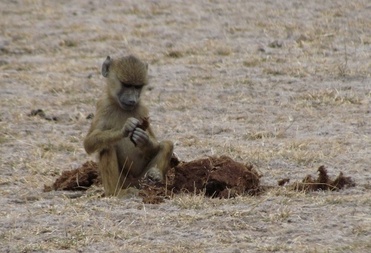
Alice and the others continued to look for food as they moved through the woodland. They turned over dried dung of large mammals such as elephant and buffalo, piece after piece. Usually they found nothing, but sometimes they found a sprouted seed or a small insect. Those made the effort worthwhile. They picked up small, dry, lentil-shaped acacia seeds. Alice found it difficult to crack open these seeds in her molars, but the seeds were abundant and good. She enjoyed their mustard-garlic smell. Earlier in the year, Alice and the others had gotten fresh, soft acacia seeds from green pods. They were delicious that way and easy to eat, yet the seeds always made her nauseous if she ate very many of them [135].
Alice noticed that ahead of her, some of the baboons had stopped at an isolated Lycium bush and were feeding on the small, orange fruits. Soon the fruit was gone, but Alice remembered another place, far to the west, where Lycium bushes were abundant. Perhaps in the next few days her group would make a trek to that area and gorge themselves on the fruit [135].
By mid-morning, the baboons had reached the edge of the woodland. The baboons moved away from the trees out onto the open, flat plains. They soon came to an area with many tussocks of one of their favorite grasses, Sporobolus rangei, the corm of which helped sustain the baboons during the long dry season [52, 135]. The file formation became a long rank as the baboons spread out to feed [4]. Getting at the grass corms was hard work. Each baboon dug into the earth until some of the subterranean corms could be pulled loose from the tussock. Then the roots and outer sheath of the corms were torn off, liberating the flavorful inner portion [135].
After an hour, Alice's hands were sore from digging. The sun and the dust bothered her. She was afraid of the ground-nesting plovers that kept screaming and diving at her [4]. She was hot and thirsty. She tried to get into Alto's lap so as to nurse, but Alto was busy digging and rebuffed Alice. At this age, Alice was big enough that Alto couldn't see where she was digging when Alice was in her lap [23, 27, 38, 41]. Alice sat immediately next to Alto, trying to stay in the shade of her mother's body.
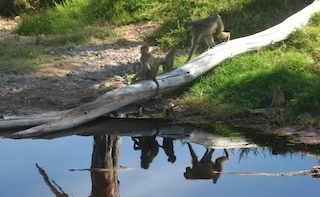
Eventually the baboons worked their way across the field of rangei grass, coalesced again, and began walking briskly to the northwest [97]. Alice knew where they were going, and she trotted ahead of her mother. At a small depression, the baboons stopped to drink from a pool that was fed by a small underground spring. Alice knew from experience to drink near the source of the pool. The rest of the water was salty and alkaline [4]. After the baboons had slaked their thirst, they rested for a while. As Alice relaxed next to her mother, Alto groomed Alice’s fur [96].
All too soon, they were on the move again. The best part of the trip was ahead of them, though. Near the dry edge of Lake Amboseli, some three kilometers from where the baboons had begun the day, they came to an area of young fever trees. Wherever the bark of these trees is broken open, a viscous, sweet gum exudes. It is the baboons' candy. They spent much of the next two hours searching the young trees for pieces of the sweet gum [20, 4, 65, 135].
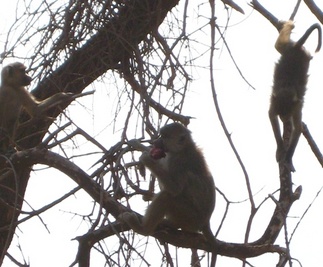
Suddenly, adult male Max began chasing a young Cape hare. He quickly caught it and began tearing through the skin with his teeth. The other baboons watched. Some of the adult males that were dominant to Max thought of trying to take the hare away from him, but it was small and they knew he would put up a fight to keep it. Among baboons, "possession is nine-points of the law" [4, 19].
Several juveniles and infants came near Max as he ate. Any that got too close were threatened away by him. The exception was Fred, who was born the same week as Alice. Max was a frequent associate of Fred's mother. He probably was Fred's father, and had treated Fred preferentially since Fred was born. As a result, when Max fed, Fred was often allowed to sit next to him and to pick up scraps of Max's food. As on other occasions, Fred now got small pieces of meat that Max dropped. Meat is a far richer food than the baboons' usual vegetarian diet, but it is not an unmixed blessing [21]: Fred, like Max, had tapeworms.
In mid-afternoon, the baboons began the long walk back to one of the woodlands and to a familiar grove of sleeping trees that they would use that night. Along the way, they stopped to feed in a field of the tall, dense Sporobolus consimilis grass. Alice was always tense when they first entered large areas of this grass. You never could be sure whether a leopard or a hyena was hiding in it, and at first the baboons startled at any sudden rustling of the grass [4]. It helped to live in a group and be able to take advantage of 40 pairs of eyes and ears [11]. Soon the baboons relaxed and began to feed. They tore off lateral branches of the grass, used their teeth to remove the tough outer layers, and then ate the soft, succulent, white core of the stem base [135].
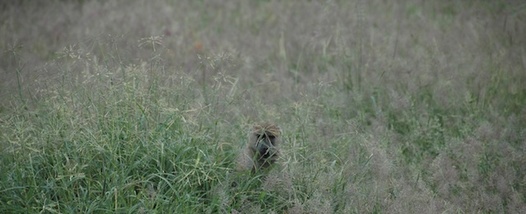
Alice had lost sight of Alto in the tall grass, but she could see three-month-old Hans clinging to his mother, Handle, and Alice knew this meant that adult male Even, who often acted as if he were Hans' godfather, probably was not far away [27]. Besides, she was reassured by the squeaking sounds around her, made when grass cores were pulled out of their sheaths. The sounds meant that she was safely surrounded by feeding baboons, even though most were out of sight in the tall grass [4]. Later, as the group approached the woodland, Alice chased a butterfly, but she couldn't catch it. For a while she joined a group of older youngsters that were playing "King of the Castle" on a Salvadora bush, but she soon quit [4]. The baboons had walked over eight kilometers in the open sun that day, and Alice was tired [129].
In the shade of a bush, she found Bristle, snuggled into his mother's lap, nursing. Alice climbed over Bristle, squeezed between him and his mother, Brush, dislodging Bristle from the nipple. All too often, Alice interrupted what others were doing, but she got away with it because her mother and her oldest sister were the two highest-ranking females in the group. None of the other females dared to do anything punitive to little Alice.
The sun was now dropping near the horizon. Alice's attention was caught by the flight of hundreds of white egrets, coming to roost. The baboons of Alice’s group moved slowly closer to the sleeping trees, a different grove than the one they used the night before [50]. This grove, too, was one that was big enough for all members of the group to find high spots on trees whose branches were not very horizontal or very low, important for safety from predation by leopards at night. Well before it got dark, they would be safely up in the trees. With the setting of the sun, the dry air quickly became chilly. Alice snuggled against Alto and was soon asleep.
